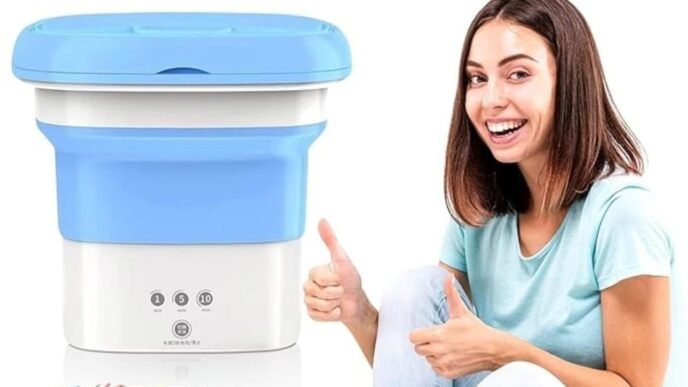Owning a portable washing machine can be a huge convenience, especially for those with limited space or on the go. However, just like any other household appliance, it requires regular maintenance to keep it running smoothly. Neglecting this can lead to decreased performance, costly repairs, and a shortened lifespan for your machine. In this guide, we’ll walk you through some straightforward yet essential maintenance tips to ensure your portable washing machine stays in top condition for years to come. Stick with us, and you’ll learn how easy it is to maintain your portable washing machine efficiently and effectively.
Why Maintenance is Crucial for Your Portable Washing Machine
Making sure your portable washing machine is maintained properly isn’t just a good idea—it’s essential. Consistent upkeep ensures performance is optimal, keeps utility bills in check, and prevents unwanted interruptions. Here’s a deeper look at why maintenance is so crucial.
Prolonged Lifespan
Much like a car needs oil changes and tire rotations, your washing machine needs attention too. Regular maintenance can significantly prolong the lifespan of your appliance. By routinely checking hoses for wear and keeping the drum clean, you can avoid wear and tear that can lead to costly repairs.
Improved Efficiency
An efficiently running machine uses less water and energy, which not only saves you money but is also better for the environment. Cleaning your portable washer’s filters and removing lint and residue can keep the machine running smoothly. Efficient machines clean better and quicker, meaning you spend less time doing laundry.
Cost Savings on Repairs
Neglecting maintenance can lead to minor issues escalating into major problems. A small leak could eventually flood your home if not addressed, leading to expensive repairs. Regular check-ups ensure that components like hoses, seals, and pumps are in good working order. Keeping everything in top shape helps you avoid unexpected expenses.
Avoiding Downtime
A broken washing machine can disrupt your entire routine. Ensuring that your machine is well-maintained minimizes the risk of off-schedule breakdowns. Maintenance helps you spot potential problems before they become real issues, ensuring your laundry schedule stays on track.
Enhances Performance Quality
Dirt, soap scum, and lime-scale buildup can affect washing performance. Regularly cleaning the drum and dispensers keeps clothes smelling fresh and looking clean. Using the correct detergent and not overloading can also prevent buildup that can degrade performance over time. Following proper maintenance tips will keep the machine running at its best.
In summary, maintaining your portable washing machine is vital for its performance and longevity. By doing simple, routine checks and cleaning, you can enjoy hassle-free laundry days and save a lot in the long run. This investment of a little time translates to numerous benefits including cost savings, less downtime, and improved efficiency.
Daily and Weekly Maintenance Tips
Keeping your portable washing machine in good condition requires some routine yet essential habits. Simple actions can prevent major issues and help prolong the life and effectiveness of your appliance.
Empty Pockets and Check for Foreign Objects
Before loading your portable washing machine, always make sure to empty all pockets and check for any foreign objects. Items like coins, keys, and tissues can cause significant damage if left inside the drum.
Neglecting this step could lead to:
- Clogged hoses: Small objects can block the drainage, causing water flow problems.
- Damaged drum or pump: Hard items like coins can dent or scratch the internal components.
- Poor washing performance: Lint from tissues can cling to clothes, making your wash ineffective.
Taking just a few seconds to double-check your pockets can save you from expensive repairs and downtime.
Avoid Overloading the Machine
Avoiding overloading your washing machine is crucial for maintaining its performance and extending its lifespan. A portable washer has a smaller drum compared to a full-sized machine, so it’s even more susceptible to overloading issues.
Here are the problems caused by overloading:
- Reduced cleaning efficiency: Clothes don’t have enough room to move around and get cleaned thoroughly.
- Excess strain on the motor: Overloading puts extra pressure on the motor and other components, which can lead to premature wear and tear.
- Imbalanced load issues: An overloaded machine is more likely to go off balance, causing noise and potential damage.
To keep your washer in top shape:
- Follow the manufacturer’s recommendations on load size.
- Break larger loads into smaller, more manageable ones.
- Ensure clothes are evenly distributed within the drum.
By paying attention to load size, you help ensure that your portable washing machine operates efficiently and lasts longer.
Use the Right Amount and Type of Detergent
Using the correct type and amount of detergent is key to preventing build-up and ensuring your machine runs smoothly. Too much detergent can cause excess suds, meaning residue can stay in the drum and hoses.
Why this matters:
- Avoids residue build-up: Excess suds can leave residue, leading to unpleasant odors and potential clogs.
- Enhances washing efficiency: The right detergent amount ensures that clothes are properly rinsed without leftover soap.
- Prevents damage: Some detergents can be harsher on the machine’s components; using a recommended type ensures longevity.
Tips for detergent use:
- Follow instructions: Always refer to the detergent packaging for proper measurements.
- Use high-efficiency (HE) detergents: These create fewer suds and are typically more effective in smaller quantities. Read why high-efficiency detergent is recommended.
- Consider liquid detergents as they do not clump as much as powder types.
By using the proper detergent, you maintain your washing machine in top condition and keep clothes cleaner and fresher. By incorporating these simple daily and weekly maintenance tips, you’ll keep your portable washing machine performing its best for years to come.
Monthly Maintenance Practices
Maintaining your portable washing machine isn’t just about following routine habits; it also involves monthly practices that help ensure long-lasting performance. These deeper cleaning tasks remove build-up and prevent potential issues from occurring down the line.
Clean the Lint Filter and Drainage Hose
Cleaning the lint filter and drainage hose is essential to maintain your washing machine’s efficiency. Follow these steps to keep them in tip-top shape:
- Unplug the Machine: Safety first! Always make sure the machine is unplugged before starting any maintenance work.
- Locate the Lint Filter: Depending on your model, this could be inside the drum, in the agitator, or near the door seal. Refer to the user manual if necessary.
- Remove the Filter: Gently remove the lint filter. You might need to unscrew or unclip it.
- Clean the Filter: Rinse the filter under running water to remove lint and debris. Use a soft brush if needed. Ensure it’s thoroughly dry before putting it back.
- Inspect the Drainage Hose: Check the hose for any blockages or debris. Detach it from the machine and run water through it to clear any clogs.
- Reassemble: Once everything is clean and dry, reattach the hose and filter, and plug the machine back in.
Keeping these components clean prevents backups and keeps your machine running smoothly. Need more details on cleaning a lint filter? Check out this comprehensive guide.
Run a Maintenance Wash
A maintenance wash is crucial to keeping your machine fresh and free from residues. Here’s how to do it:
- Empty the Machine: Ensure there are no clothes or other items inside the drum.
- Set to the Hottest Cycle: Choose the highest temperature setting to help dissolve any build-up completely.
- Add Cleaning Agents:
- Vinegar: Pour two cups of white vinegar into the detergent dispenser. Vinegar helps to dissolve soap scum and disinfects the machine.
- Baking Soda: Alternatively, you can add half a cup of baking soda directly into the drum. Baking soda is great for deodorizing and cleaning.
- Start the Cycle: Run the cycle as you would normally. The combination of hot water and cleaning agents will work wonders in removing grime and odors.
- Wipe the Drum: Once the cycle is complete, wipe the inside of the drum with a clean, dry cloth to remove any remaining moisture.
- Leave the Door Open: Allow the drum to air dry by leaving the door open for a few hours. This prevents the growth of mold and mildew.
It’s good practice to run a maintenance wash at least once a month. For more tips on deep cleaning, have a look at this detailed guide.
By dedicating a little time to monthly maintenance, you ensure your portable washing machine remains efficient and dependable. These small efforts can prevent costly repairs and prolong the life of your appliance.
Quarterly and Semi-Annual Maintenance
Maintaining your portable washing machine isn’t just about daily or weekly habits. Quarterly and semi-annual maintenance help ensure your machine performs efficiently and lasts longer. Simple checks and cleaning tasks done on a less frequent basis can prevent major issues and keep everything running smoothly.
Inspect and Clean the Inlet Filters
Water inlet filters are crucial for proper water flow into your machine. Over time, these filters can become clogged with sediment, reducing the efficiency of your washing machine.
- Turn Off Water Supply: Start by turning off the water supply to prevent any water leakage during the process.
- Locate the Inlet Filters: Typically, inlet filters are found where the hoses connect to the washing machine. They can be small screens inside the valve connections.
- Remove the Filters: Carefully detach the hoses and remove the filters. Use pliers if needed but be gentle to avoid damage.
- Clean the Filters: Rinse the filters under running water to remove any debris and sediment build-up. Use a soft brush if necessary. For harder-to-remove grime, soak the filters in vinegar for a few minutes before scrubbing.
- Reassemble and Test: After cleaning, reattach the filters and hoses. Turn on the water supply and run a short cycle to ensure everything is properly connected and functioning without leaks.
By keeping the inlet filters clean, you ensure optimal water flow, reduce stress on the machine’s mechanisms, and maintain washing efficiency. For more detailed instructions, check out this comprehensive guide on cleaning inlet filters.
Check for Leaks and Inspect Hoses
Hoses are essential components of your portable washing machine that require regular inspection to prevent leaks and water damage.
- Inspect Hoses for Wear and Tear: Look for any visible signs of wear, such as cracks, bulges, or fraying on the hoses. If you notice any damage, it’s important to replace the hose immediately to avoid leaks.
- Tighten Connections: Ensure that the hose connections are tight and secure. Loose connections can lead to leaks.
- Check for Leaks: After inspecting for physical damage, run the machine and check every connection for any signs of leaks. Use a dry cloth around the connection points to detect wet spots.
- Replace Hoses Periodically: It’s recommended to replace the hoses every three to five years, even if they appear to be in good condition. This is a preventive measure to avoid unexpected failures.
When replacing hoses, consider using stainless steel braided hoses which are more durable than rubber ones. Following these steps can prevent leaks and water damage, ensuring your washing machine runs smoothly. For more information on maintaining your washing machine hoses, refer to this handy guide on hose maintenance.
Quarterly and semi-annual maintenance checks might seem like a hassle, but they are essential for keeping your portable washing machine in perfect condition. By routinely inspecting and cleaning the inlet filters and checking hoses for leaks, you can significantly reduce the risk of unexpected breakdowns and prolong the life of your machine.
Storage and Handling Tips
Proper storage and handling of your portable washing machine are crucial for its durability and performance. Ensuring your machine is placed correctly, securing connections, and minimizing vibrations can significantly extend its lifespan.
Proper Placement and Leveling
Placing your portable washing machine on a level surface is essential for preventing unnecessary strain and damage to the appliance. An uneven surface can cause the machine to rock and vibrate excessively, which can wear down its components over time.
- Find a Level Surface: Look for a flat, stable area to place your washer. Avoid placing it on carpets or uneven tiles.
- Adjust the Leveling Feet: Most portable washing machines have adjustable feet. Twist them to raise or lower each corner of the machine until it sits firmly and level. You can use a spirit level to check the balance.
- Regular Checks: Occasionally check the machine’s level, especially if it’s been moved. Changes in flooring or settling can alter the balance.
Securing the proper placement and leveling of your portable washing machine not only enhances its efficiency but also prevents unnecessary wear and tear.
Secure Connections and Avoiding Vibration
Ensuring that all connections are secure and minimizing vibrations are critical to maintaining the integrity of your portable washing machine and preventing damage to your home.
- Secure Hoses and Cords: Make sure the inlet and outlet hoses are tightly connected to avoid leaks. The power cord should be securely plugged in and not frayed or exposed.
- Use Anti-Vibration Pads: Placing anti-vibration pads under the feet of the washer can help reduce noise and movement. These pads can be found at most home improvement stores and are an affordable way to keep your machine stable.
- Balance Your Load: Distributing clothes evenly inside the drum can prevent the machine from becoming unbalanced. An unbalanced load can cause excessive shaking and increase the risk of component damage.
- Monitor During Operation: Stay nearby when the machine is running, especially during high-speed cycles. This way, you can quickly pause and rebalance the load if vibrations become excessive.
Securing your portable washing machine’s connections and minimizing vibrations not only protect the appliance itself but also reduce the risk of damage to the surrounding area. For more detailed guidance, consider this comprehensive guide.
By following these storage and handling tips, your portable washing machine will remain in great shape, ensuring it works efficiently and lasts for many years. These small yet effective actions play a significant role in maintaining your washer in optimal condition.
Troubleshooting Common Issues
Portable washing machines are a convenient solution for laundry needs, but they can sometimes encounter common issues that affect their performance. Knowing how to troubleshoot these problems can save you time and money in the long run. Let’s delve into some typical issues and practical solutions you can apply to maintain your portable washing machine efficiently.
Noisy Operation
One of the common problems you may encounter with your portable washing machine is noisy operation. The machine may produce loud sounds during the washing or spinning cycles, disrupting your peace. The noise can be a result of various factors, including unbalanced loads, loose components, or faulty parts.
Causes of Noisy Operation:
- Unbalanced Loads: Uneven distribution of clothes inside the drum can cause the machine to shake and create noise.
- Loose Components: Inspect the machine’s exterior and interior parts like the agitator, drum, or motor for any loose fittings.
- Worn Out Bearings: Over time, bearings can wear out, leading to loud grinding or banging noises during operation.
Solutions to Reduce or Eliminate Noise:
- Rebalance Loads: Make sure to distribute items evenly within the drum to prevent vibrations.
- Tighten Loose Components: Check and tighten any loose screws or connections that could be causing the noise.
- Replace Worn Out Bearings: If the noise persists, consider replacing worn bearings to restore smooth and quiet operation.
For additional insights on troubleshooting noisy operation, refer to this detailed guide on noise reduction.
Water Drainage Problems
Another common issue with portable washing machines is water drainage problems. When the machine fails to drain water properly, it can lead to issues like standing water in the drum, incomplete cycles, or foul odors emanating from the washer. Understanding the potential causes of drainage issues can help you address them effectively.
Identifying Potential Drainage Issues:
- Clogged Drain Hose: Blockages in the drain hose can prevent proper water drainage from the machine.
- Faulty Pump: A malfunctioning pump can hinder the expulsion of water from the drum, resulting in drainage problems.
Effective Troubleshooting Methods:
- Check the Drain Hose: Inspect the drain hose for any obstructions or kinks that may impede water flow. Clear out any debris or buildup.
- Examine the Pump: Verify that the pump is functioning correctly by listening for its operation during the drainage cycle. Clean or replace the pump if necessary.
To dive deeper into troubleshooting water drainage issues, explore this insightful resource on drain problems.
By addressing noisy operation and water drainage problems promptly, you can ensure that your portable washing machine maintains peak performance and longevity. Taking proactive measures to troubleshoot common issues will help you enjoy hassle-free laundry days with your trusty appliance.
Read More: Top 10 Portable Washing Machines for Every Need
Conclusion – Maintain Your Portable Washing Machine
Regular maintenance is the key to ensuring your portable washing machine operates at its best for years to come. By following simple practices like emptying pockets, avoiding overloading, using the right detergent, and conducting monthly, quarterly, and semi-annual maintenance, you can prevent common issues and prolong the lifespan of your appliance.
Maintaining your portable washing machine isn’t just about cleanliness; it’s about efficiency and cost-effectiveness. By staying proactive with maintenance tasks and troubleshooting common problems promptly, you can enjoy hassle-free laundry days with your trusty companion. Remember, a well-maintained portable washing machine not only saves you money but also contributes to a smoother laundry routine. Incorporate these maintenance tips into your routine, and your washing machine will thank you with reliable performance and longevity.













